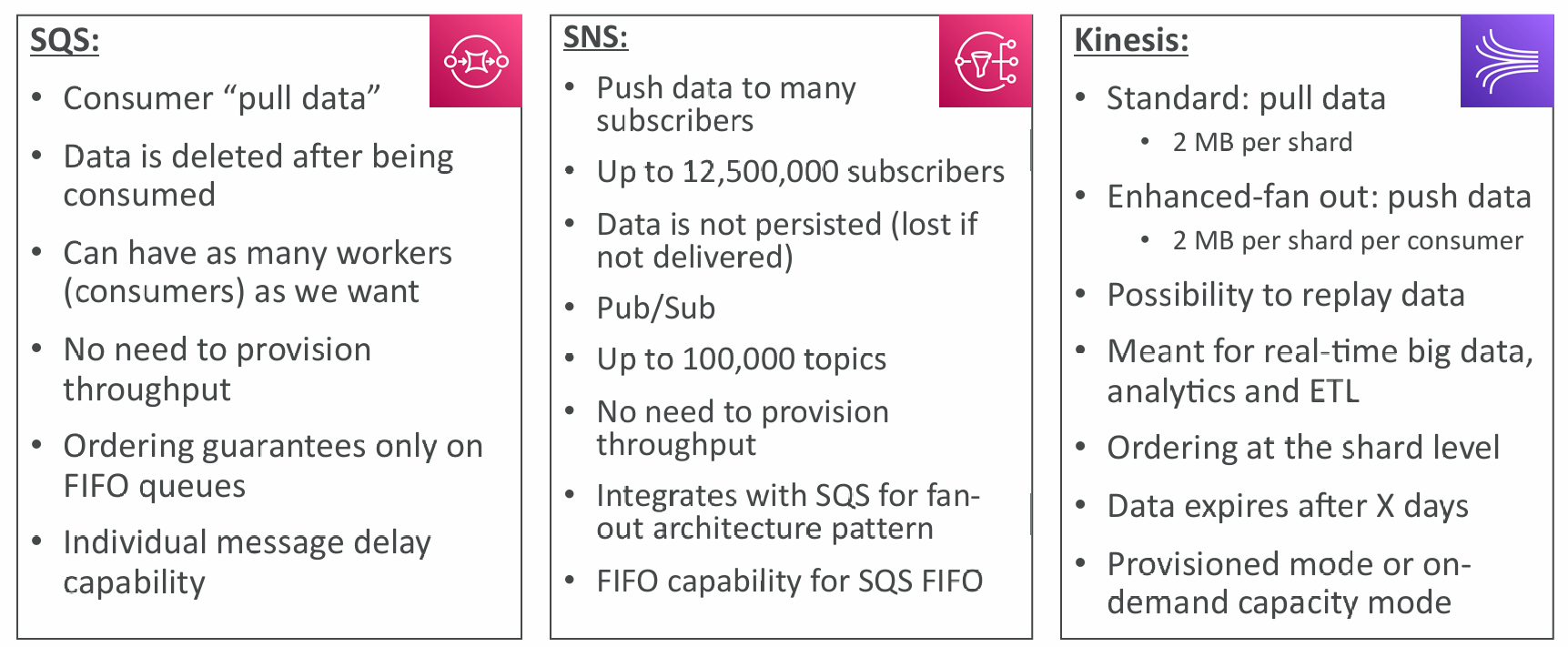Integration & Messaging
- When we start deploying multiple applications, they will inevitably need to communicate with one another
- There are two patterns of application communication
- Synchronous communications (application to application)
- Scan be problematic if there are sudden spikes of traffic
- Asynchronous / Event based (application to queue to application)
- Synchronous communications (application to application)
It’s better to decouple your applications:
- using SQS: queue model
- using SNS: pub/sub model
- using Kinesis: real-time streaming model
These services can scale independently from our application!
Amazon SQS
Standard Queue
- Oldest offering (over 10 years old)
- Fully managed service, used to decouple applications
- Attributes:
- Unlimited throughput, unlimited number of messages in queue
- Default retention of messages: 4 days, maximum of 14 days
- Low latency (<10ms on publish and receive)
- Limitation of 256KB per message sent
- Can have duplicate messages (at least once delivery, occasionally)
- Can have out of order messages (best effort ordering)
Producing Messages
- Produced to SQS using the SDK (SendMessage API)
- The message is persisted in SQS until a consumer deletes it
- Message retention: default 4 days, up to 14 days
- Example: send an order to be processed
- Order id
- Customer id
- Any attributes you want
- SQS standard: unlimited throughput
Consuming Messages
- Consumers (running on EC2 instances, servers, or AWS Lambda)…
- Poll SQS for messages (receive up to 10 messages at a time)
- Process the messages (example: insert the message into an RDS database)
- Delete the messages using the DeleteMessage API

Multiple EC2 Instances Consumers
- Consumers receive and process messages in parallel
- At least once delivery
- Best-effort message ordering
- Consumers delete messages after processing them
- We can scale consumers horizontally to improve throughput of processing
Auto Scaling Group (ASG)
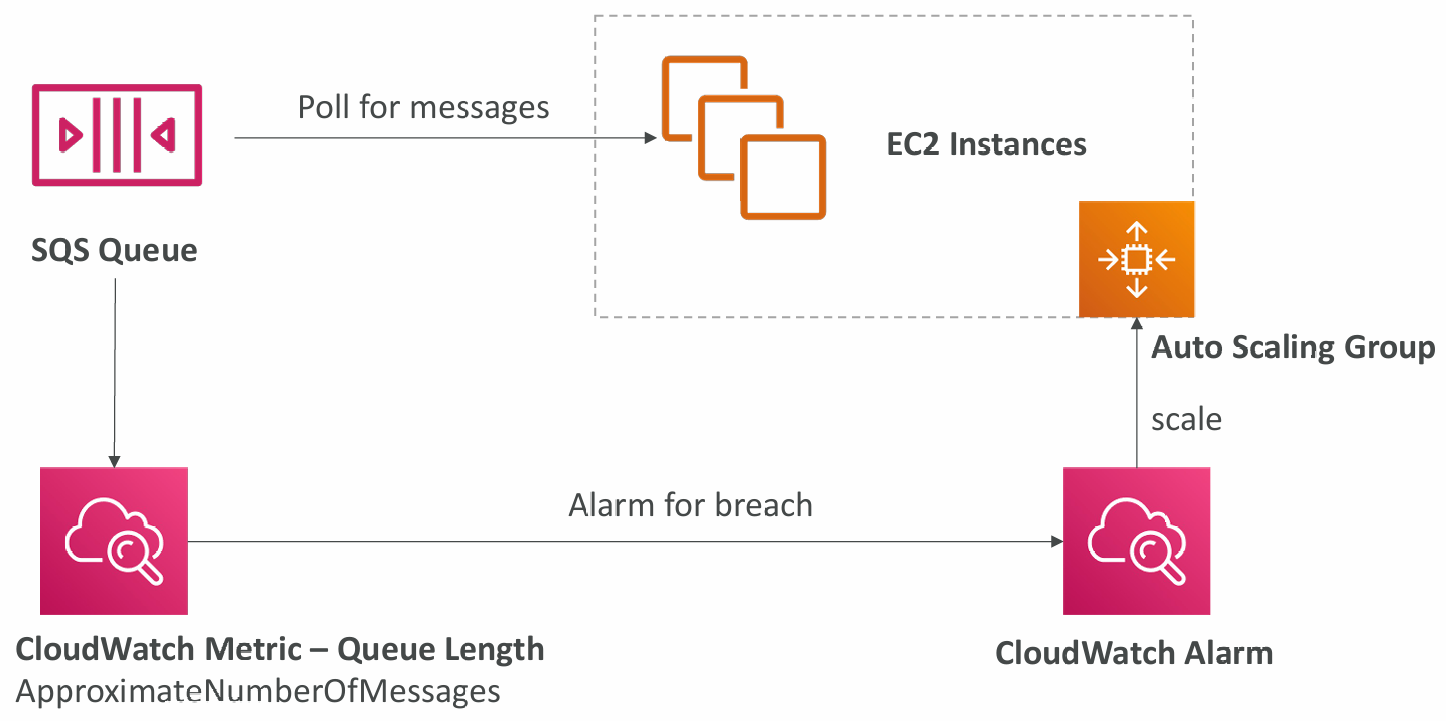
Decoupling application tiers

Security
- Encryption:
- In-flight encryption using HTTPS API
- At-rest encryption using KMS keys
- Client-side encryption if the client wants to perform encryption/decryption itself
- Access Controls: IAM policies to regulate access to the SQS API
- SQS Access Policies (similar to S3 bucket policies)
- Useful for cross-account access to SQS queues
- Useful for allowing other services (SNS, S3…) to write to an SQS queue
Queue Access Policy
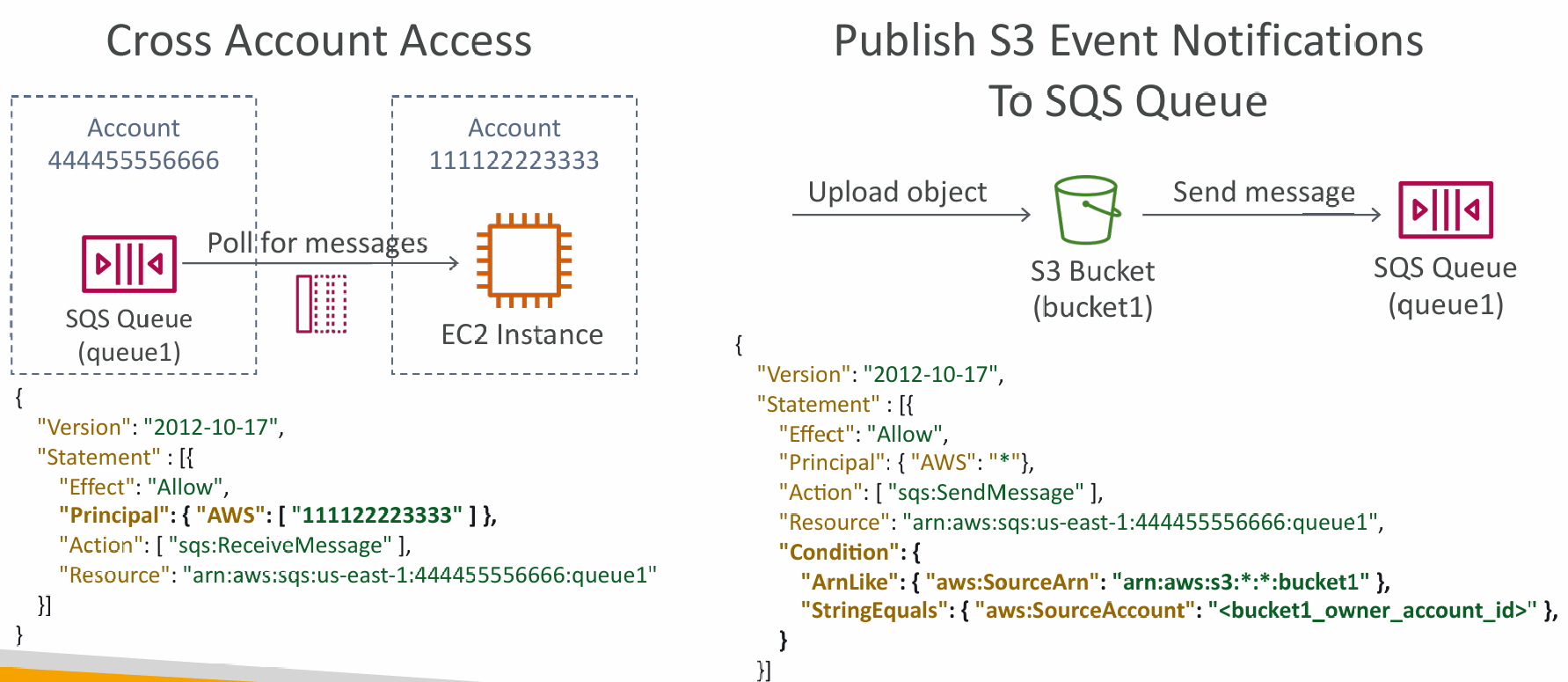
Message Visibility Timeout
- After a message is polled by a consumer, it becomes invisible to other consumers
- By default, the “message visibility timeout” is 30 seconds
- That means the message has 30 seconds to be processed
- After the message visibility timeout is over, the message is “visible” in SQS

- If a message is not processed within the visibility timeout, it will be processed twice
- A consumer could call the ChangeMessageVisibility API to get more time
- If visibility timeout is high (hours), and consumer crashes, re-processing will take time
- If visibility timeout is too low (seconds), we may get duplicates
Dead Letter Queue (DLQ)
- If a consumer fails to process a message within the Visibility Timeout the message goes back to the queue!
- We can set a threshold of how many times a message can go back to the queue
- After the MaximumReceives threshold is exceeded, the message goes into a Dead Letter Queue (DLQ)
- Useful for debugging
- DLQ of a FIFO queue must also be a FIFO queue
- DLQ of a Standard queue must also be a Standard queue
- Make sure to process the messages in the DLQ before they expire:
- Good to set a retention of 14 days in the DLQ
DLQ – Redrive to Source
- Feature to help consume messages in the DLQ to understand what is wrong with them
- When our code is fixed, we can redrive the messages from the DLQ back into the source queue (or any other queue) in batches without writing custom code
Delay Queue
- Delay a message (consumers don’t see it immediately) up to 15 minutes
- Default is 0 seconds (message is available right away)
- Can set a default at queue level
- Can override the default on send using the DelaySeconds parameter
Long Polling
- When a consumer requests messages from the queue, it can optionally “wait” for messages to arrive if there are none in the queue
- This is called Long Polling
- LongPolling decreases the number of API calls made to SQS while increasing the efficiency and decreasing the latency of your application.
- The wait time can be between 1 sec to 20 sec (20 sec preferable)
- Long Polling is preferable to Short Polling
- Long polling can be enabled at the queue level or at the API level using ReceiveMessageWaitTimeSeconds
Extended Client
- Message size limit is 256KB, how to send large messages, e.g. 1GB?
- Using the SQS Extended Client (Java Library)
Must know API
- CreateQueue (MessageRetentionPeriod), DeleteQueue
- PurgeQueue: delete all the messages in queue
- SendMessage (DelaySeconds), ReceiveMessage, DeleteMessage
- MaxNumberOfMessages: default 1, max 10 (for ReceiveMessage API)
- ReceiveMessageWaitTimeSeconds: Long Polling
- ChangeMessageVisibility: change the message timeout
Note: Batch APIs for SendMessage, DeleteMessage, ChangeMessageVisibility helps decrease your costs
FIFO Queue
- FIFO = First In First Out (ordering of messages in the queue)
- Limited throughput: 300 msg/s without batching, 3000 msg/s with
- Exactly-once send capability (by removing duplicates)
- Messages are processed in order by the consumer
Deduplication
- De-duplication interval is 5 minutes
- Two de-duplication methods:
- Content-based deduplication: will do a SHA-256 hash of the message body
- Explicitly provide a Message Deduplication ID
Message Grouping
- If you specify the same value of MessageGroupID in an SQS FIFO queue, you can only have one consumer, and all the messages are in order
- To get ordering at the level of a subset of messages, specify different values for MessageGroupID
- Messages that share a common Message Group ID will be in order within the group
- Each Group ID can have a different consumer (parallel processing!)
- Ordering across groups is not guaranteed
Amazon SNS
What if you want to send one message to many receivers?
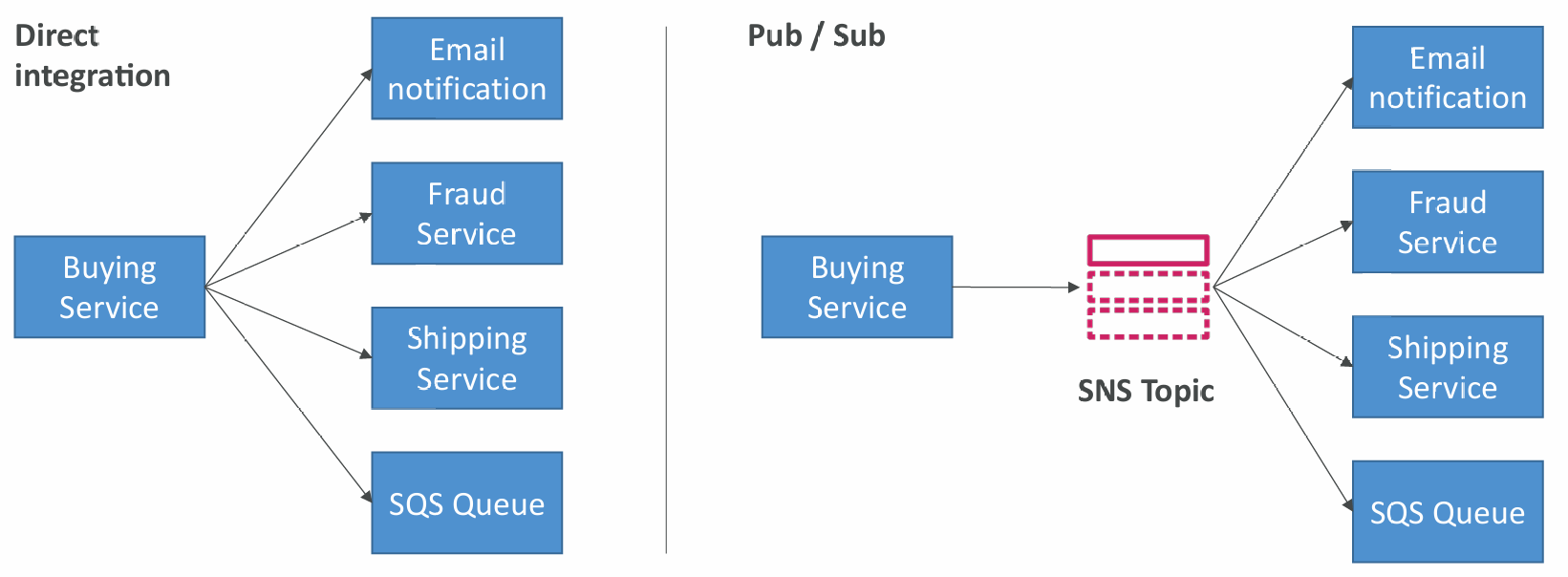
- The “event producer” only sends message to one SNS topic
- As many “event receivers” (subscriptions) as we want to listen to the SNS topic notifications
- Each subscriber to the topic will get all the messages (note: new feature to filter messages) -Up to 12,500,000 subscriptions per topic
- 100,000 topics limit
- Subscribers: SQS, Lambda, Kinesis Data Firehose, HTTP(S) Endpoints, SMS & Mobile Notifications, Emails
Integrations
- Many AWS services can send data directly to SNS for notifications
- Examples: CloudWatch, AWS Budgets, Lambda, DynamoDB, S3, Auto Scaling Groups, and many more...
How to publish
- Topic Publish (using the SDK)
- Create a topic
- Create a subscription (or many)
- Publish to the topic
- Direct Publish (for mobile apps SDK)
- Create a platform application
- Create a platform endpoint
- Publish to the platform endpoint
- Works with Google GCM, Apple APNS, Amazon ADM…
Security
- Encryption:
- In-flight encryption using HTTPS API
- At-rest encryption using KMS keys
- Client-side encryption if the client wants to perform encryption/decryption itself
- Access Controls: IAM policies to regulate access to the SNS API
- SNS Access Policies (similar to S3 bucket policies):
- Useful for cross-account access to SNS topics
- Useful for allowing other services ( S3…) to write to an SNS topic
SNS + SQS: Fan Out
- Push once in SNS, receive in all SQS queues that are subscribers
- Fully decoupled, no data loss
- SQS allows for: data persistence, delayed processing and retries of work
- Ability to add more SQS subscribers over time
- Make sure your SQS queue access policy allows for SNS to write
- Cross-Region Delivery: works with SQS Queues in other regions

S3 Events to multiple queues
- For the same combination of: event type (e.g. object create) and prefix (e.g. images/) you can only have one S3 Event rule
- If you want to send the same S3 event to many SQS queues, use fan-out

SNS to Amazon S3 through Kinesis Data Firehose
SNS can send to Kinesis and therefore we can have the following solutions architecture:

FIFO Topic
- FIFO = First In First Out (ordering of messages in the topic)
- Similar features as SQS FIFO:
- Ordering by Message Group ID (all messages in the same group are ordered)
- Deduplication using a Deduplication ID or Content Based Deduplication
- Can have SQS Standard and FIFO queues as subscribers
- Limited throughput (same throughput as SQS FIFO)
Fan Out
In case you need fan out + ordering + deduplication:
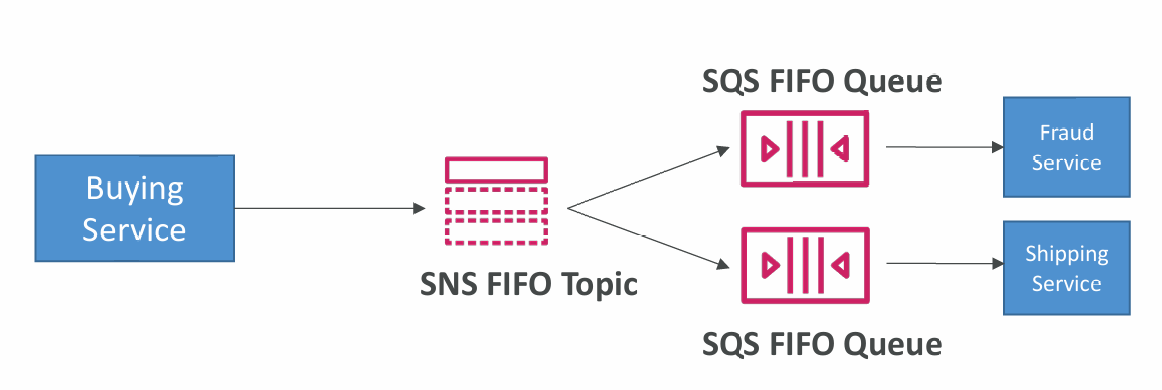
Message Filtering
- JSON policy used to filter messages sent to SNS topic’s subscriptions
- If a subscription doesn’t have a filter policy, it receives every message
Kinesis Overview
- Makes it easy to collect, process, and analyze streaming data in real-time
- Ingest real-time data such as: Application logs, Metrics, Website clickstreams, IoT telemetry data…
- Kinesis Data Streams: capture, process, and store data streams
- Kinesis Data Firehose: load data streams into AWS data stores
- Kinesis Data Analytics: analyze data streams with SQL or Apache Flink
- Kinesis Video Streams: capture, process, and store video streams
Kinesis Data Streams
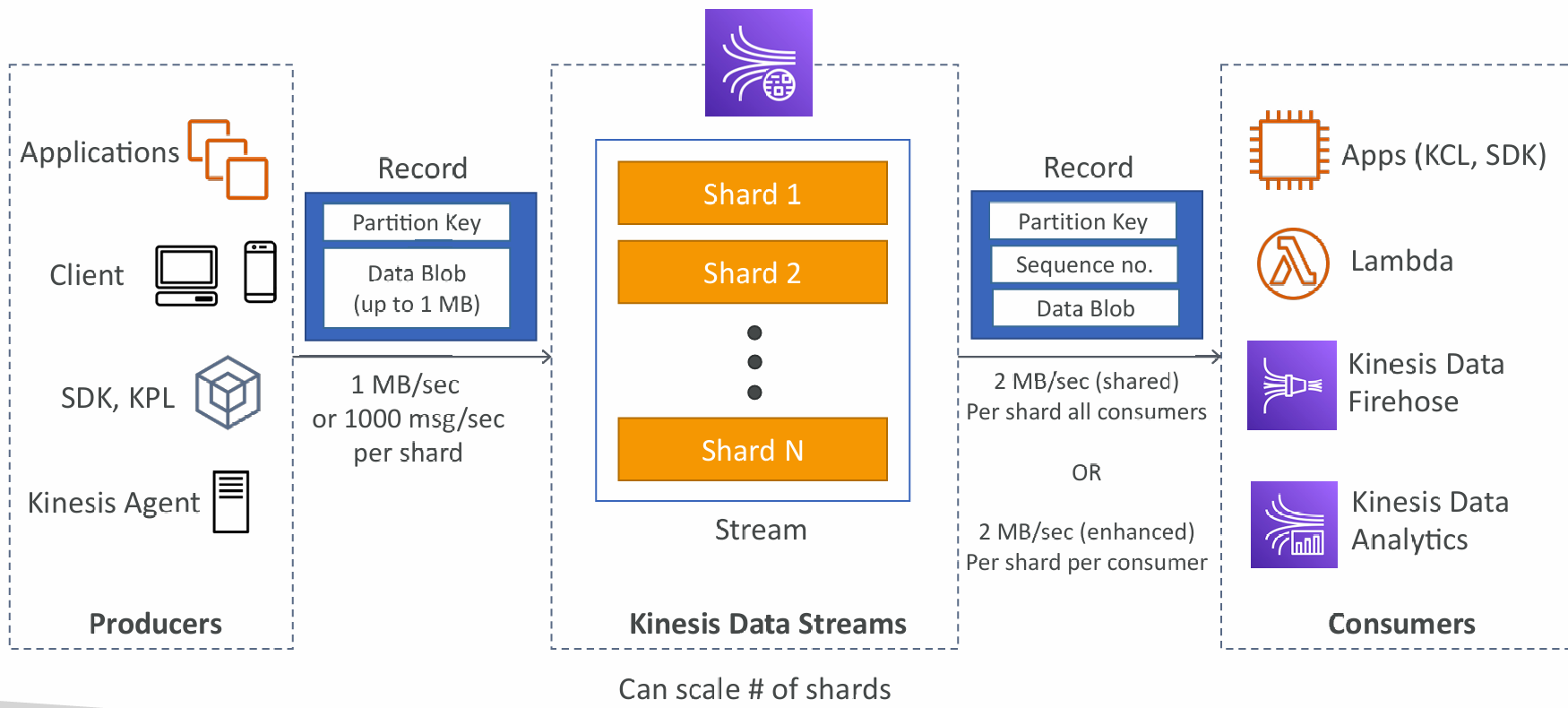
- Retention between 1 day to 365 days
- Ability to reprocess (replay) data
- Once data is inserted in Kinesis, it can’t be deleted (immutability)
- Data that shares the same partition goes to the same shard (ordering)
- Producers: AWS SDK, Kinesis Producer Library (KPL), Kinesis Agent
- Consumers:
- Write your own: Kinesis Client Library (KCL), AWS SDK
- Managed: AWS Lambda, Kinesis Data Firehose, Kinesis Data Analytics
Capacity Modes
- Provisioned mode:
- You choose the number of shards provisioned, scale manually or using API
- Each shard gets 1MB/s in (or 1000 records per second)
- Each shard gets 2MB/s out (classic or enhanced fan-out consumer)
- You pay per shard provisioned per hour
- On-demand mode:
- No need to provision or manage the capacity
- Default capacity provisioned (4 MB/s in or 4000 records per second)
- Scales automatically based on observed throughput peak during the last 30 days
- Pay per stream per hour & data in/out per GB
Security
- Control access / authorization using IAM policies
- Encryption in flight using HTTPS endpoints
- Encryption at rest using KMS
- You can implement encryption/decryption of data on client side (harder)
- VPC Endpoints available for Kinesis to access within VPC
- Monitor API calls using CloudTrail
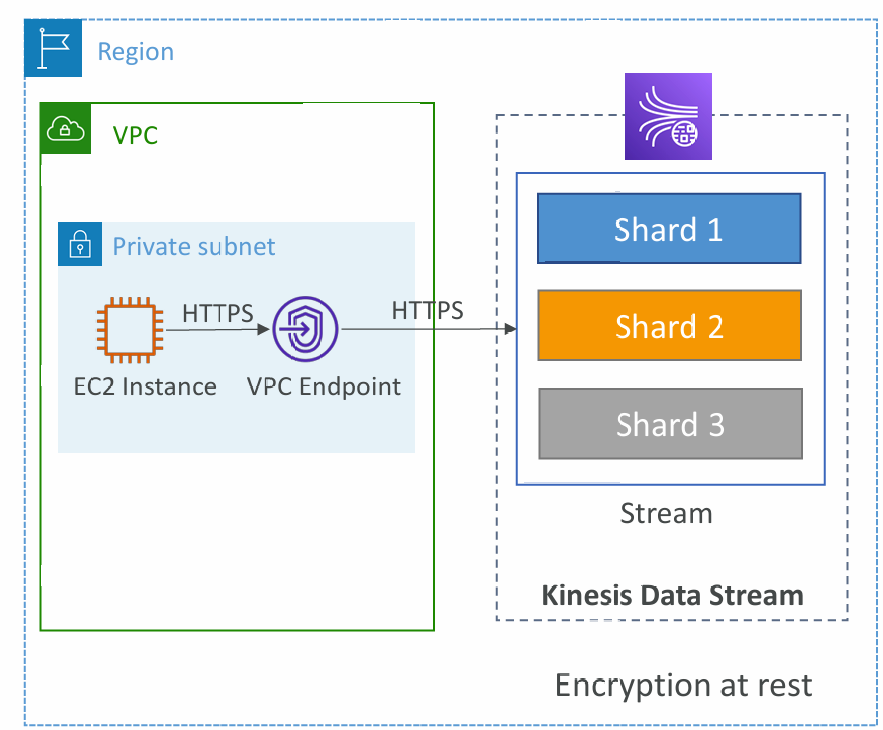
Kinesis Producers
- Puts data records into data streams
- Data record consists of:
- Sequence number (unique per partition-key within shard)
- Partition key (must specify while put records into stream)
- Data blob (up to 1 MB)
- Producers:
- AWS SDK: simple producer
- Kinesis Producer Library (KPL): C++, Java, batch, compression, retries
- Kinesis Agent: monitor log files
- Write throughput: 1 MB/sec or 1000 records/sec per shard
- PutRecord API
- Use batching with PutRecords API to reduce costs & increase throughput
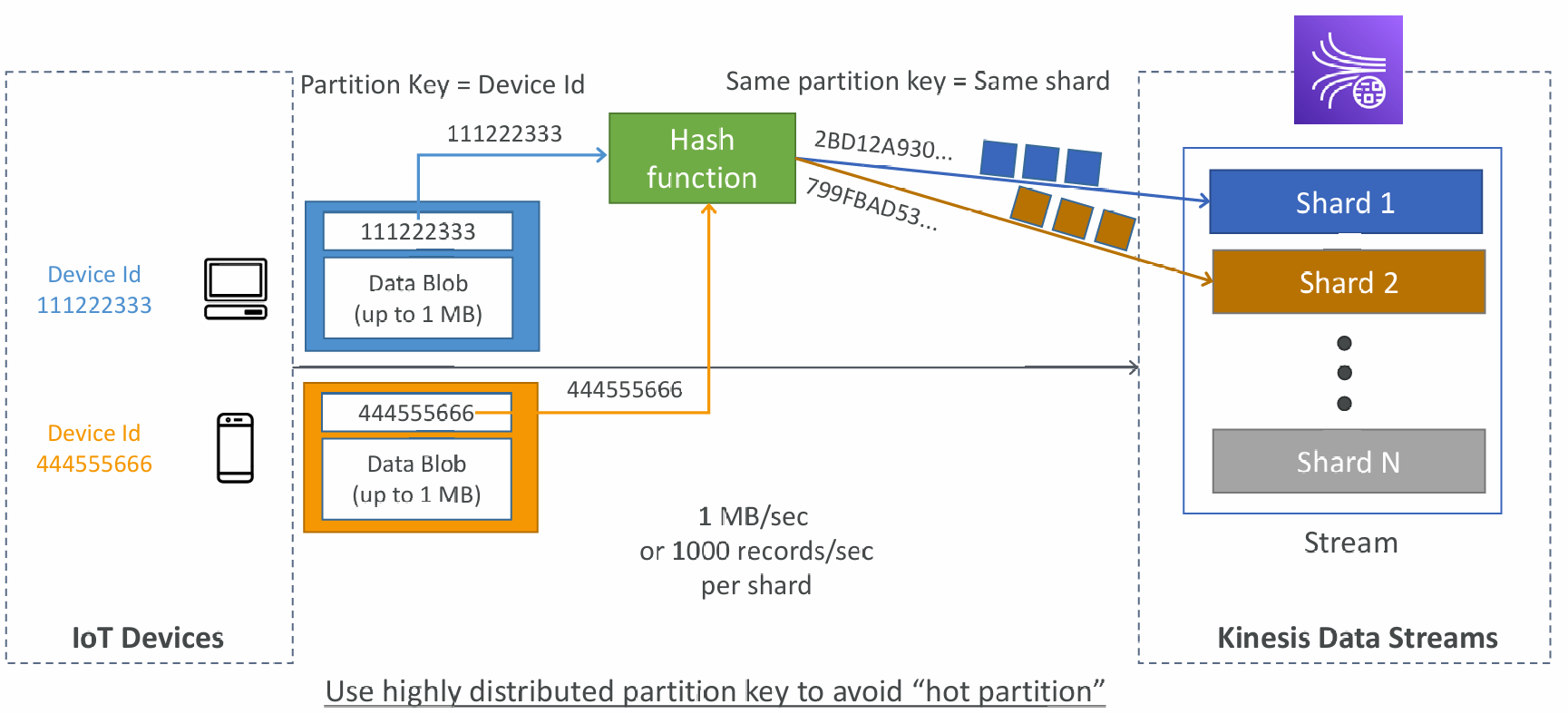
ProvisionedThroughputExceeded
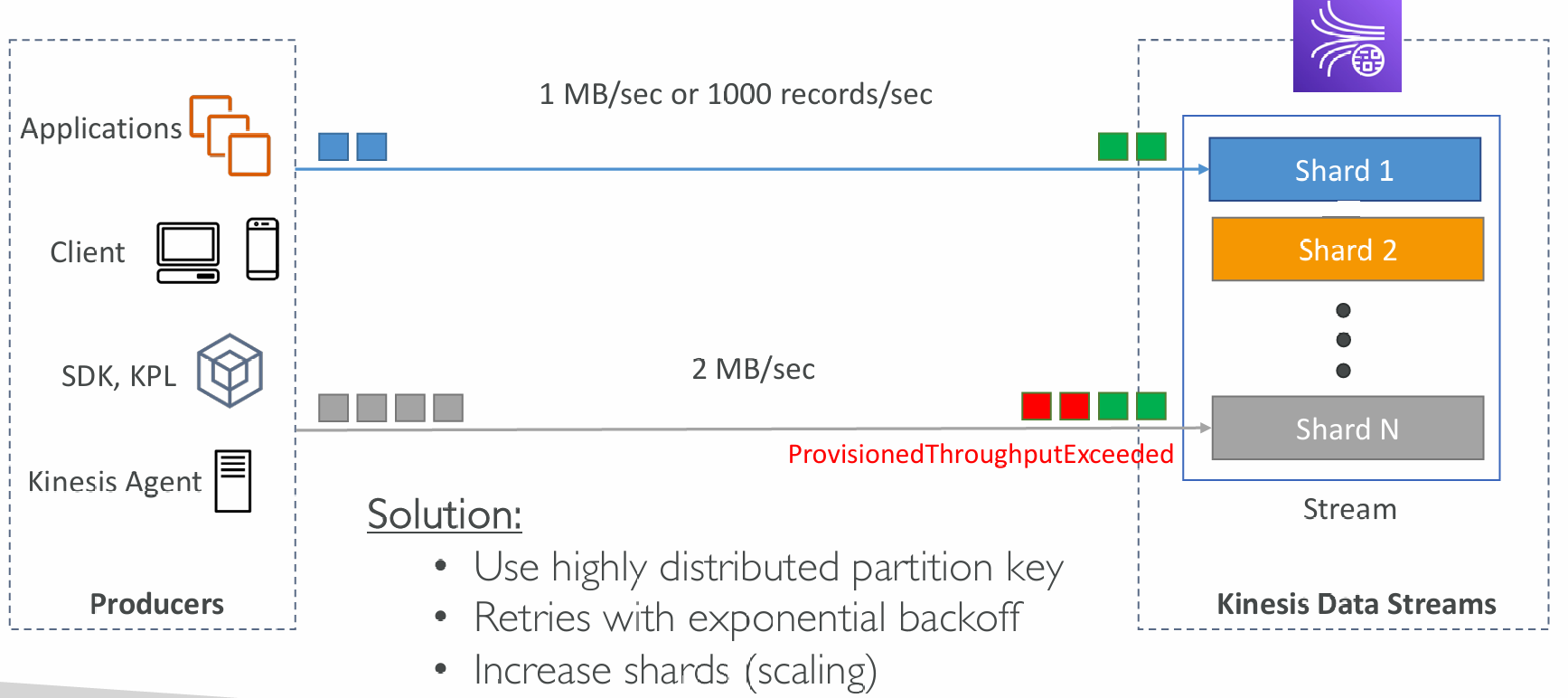
Data Streams Consumers
Get data records from data streams and process them:
- AWS Lambda
- Kinesis Data Analytics
- Kinesis Data Firehose
- Custom Consumer (AWS SDK) – Classic or Enhanced Fan-Out
- Kinesis Client Library (KCL): library to simplify reading from data stream
Custom Consumer
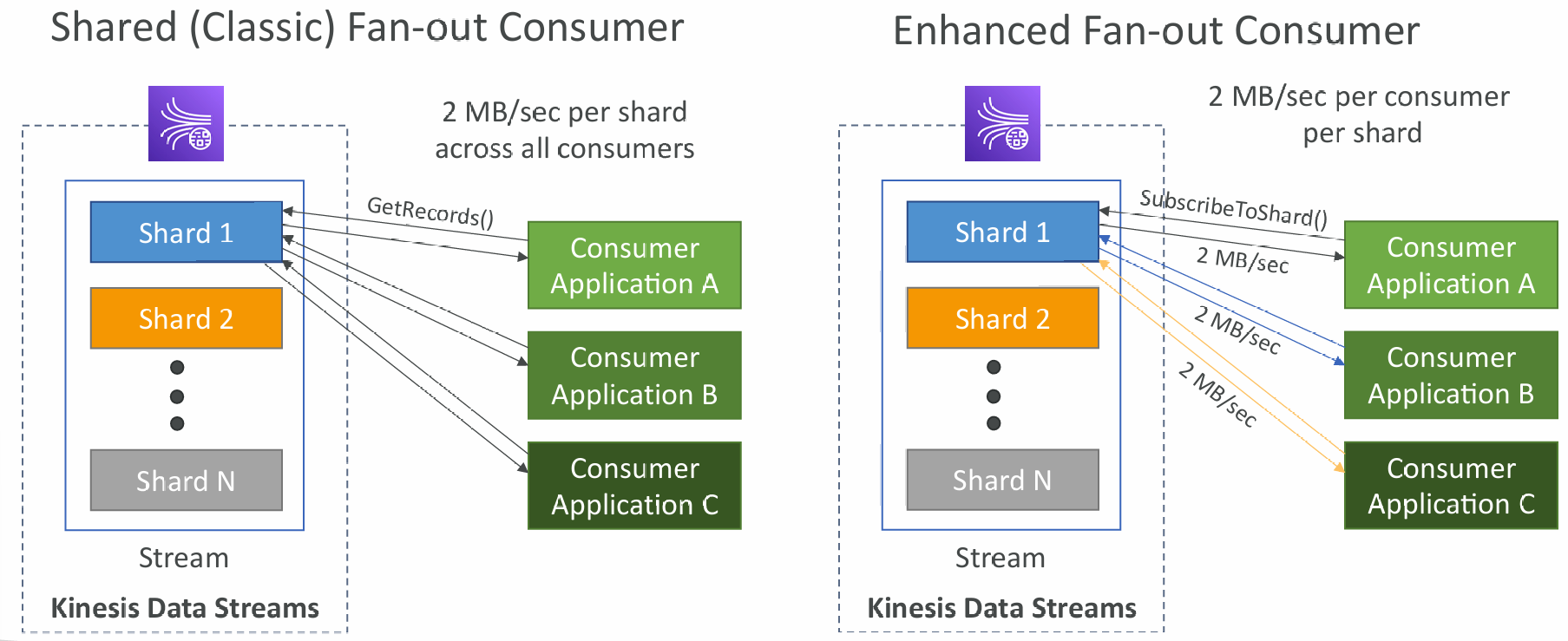
Consumers Types

Consumers: AWS Lambda
- Supports Classic & Enhanced fan-out consumers
- Read records in batches
- Can configure batch size and batch window
- If error occurs, Lambda retries until succeeds or data expired
- Can process up to 10 batches per shard simultaneously
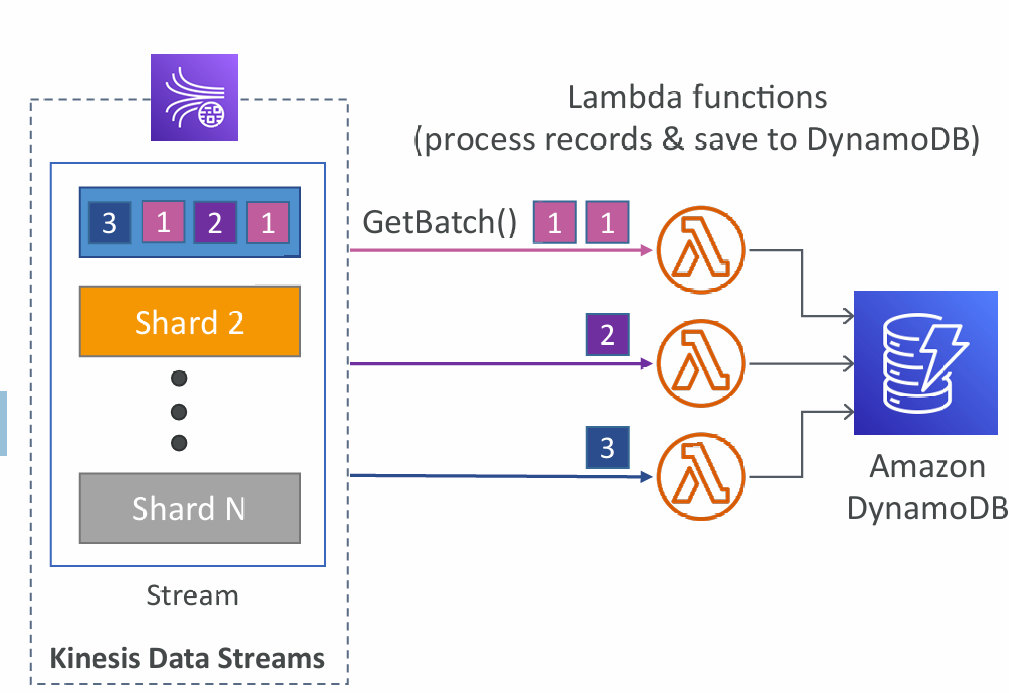
Kinesis Client Library (KCL)
- A Java library that helps read record from a Kinesis Data Stream with distributed applications sharing the read workload
- Each shard is to be read by only one KCL instance
- 4 shards = max. 4 KCL instances
- 6 shards = max. 6 KCL instances
- Progress is checkpointed into DynamoDB (needs IAM access)
- Track other workers and share the work amongst shards using DynamoDB
- KCL can run on EC2, Elastic Beanstalk, and on-premises
- Records are read in order at the shard level
- Versions:
- KCL 1.x (supports shared consumer)
- KCL 2.x (supports shared & enhanced fan-out consumer)
KCL Example
4 Shards
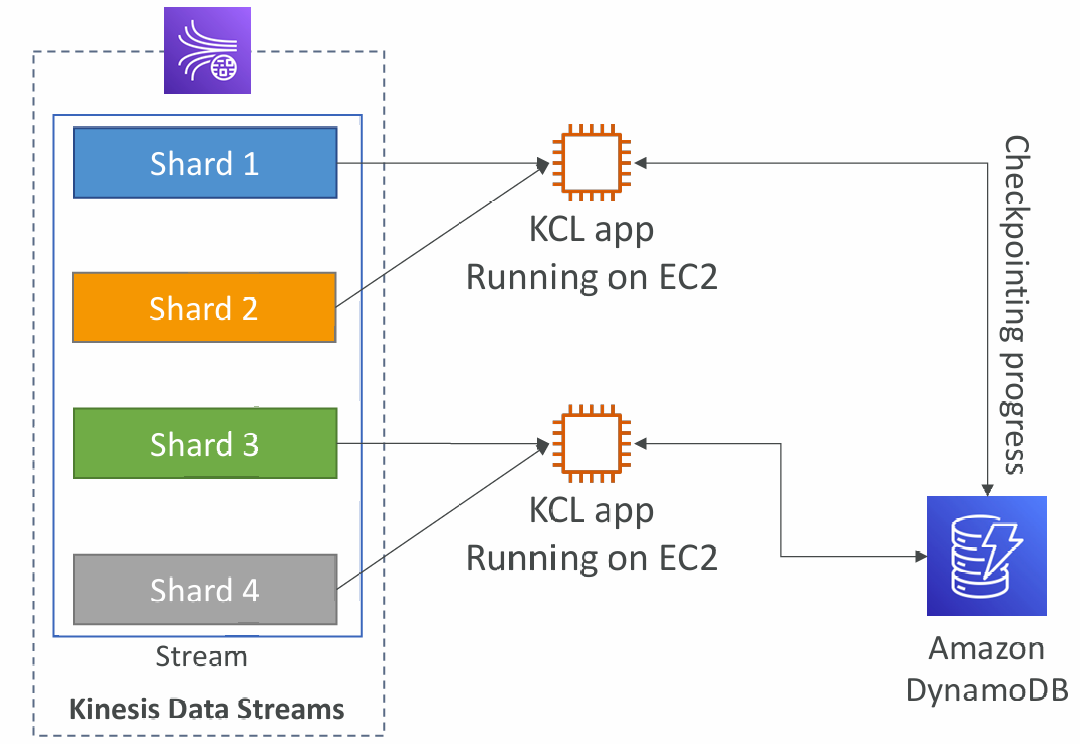
4 shards, Scaling KCL App
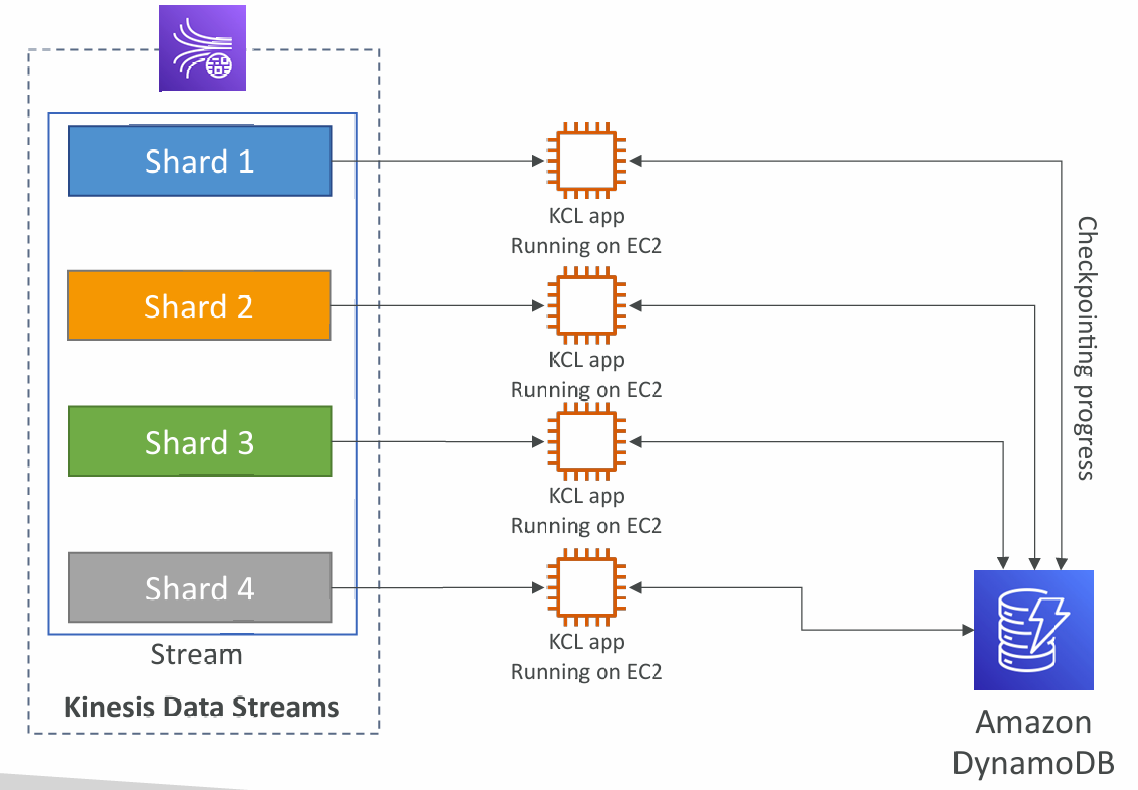
6 shards, Scaling Kinesis
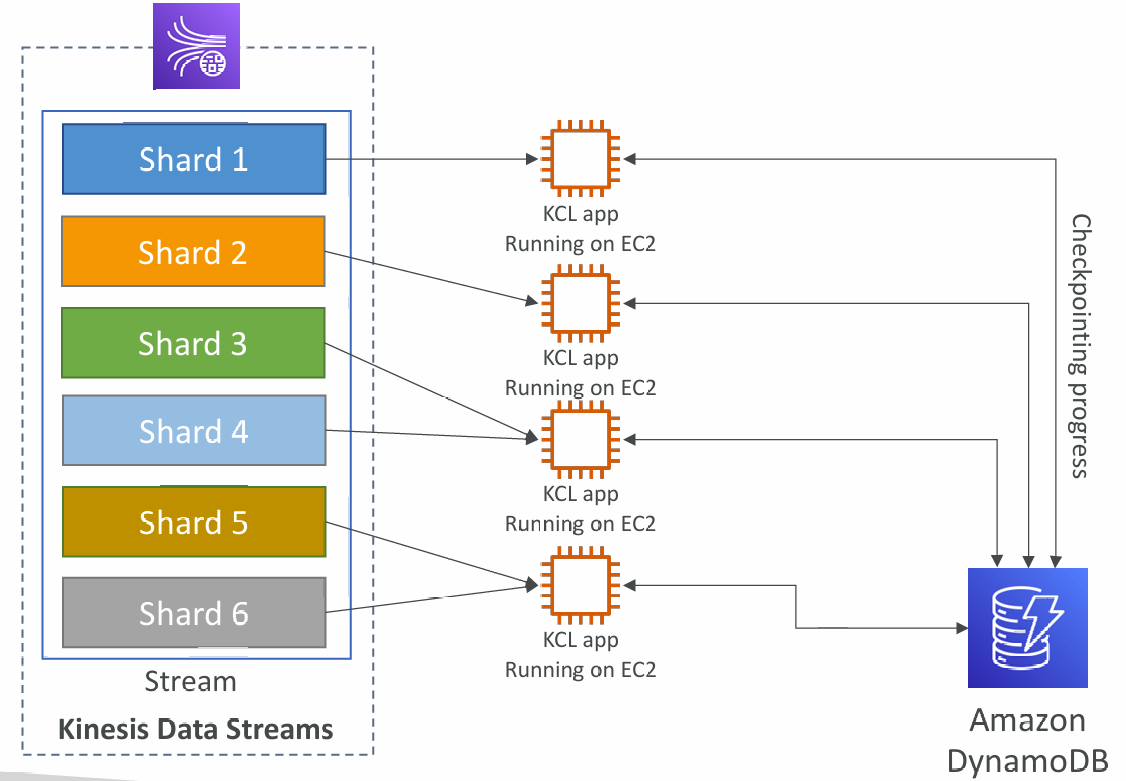
Shard Splitting
- Used to increase the Stream capacity (1 MB/s data in per shard)
- Used to divide a “hot shard”
- The old shard is closed and will be deleted once the data is expired
- No automatic scaling (manually increase/decrease capacity)
- Can’t split into more than two shards in a single operation
Merging Shards
- Decrease the Stream capacity and save costs
- Can be used to group two shards with low traffic (cold shards)
- Old shards are closed and will be deleted once the data is expired
- Can’t merge more than two shards in a single operation
Kinesis Data Firehose
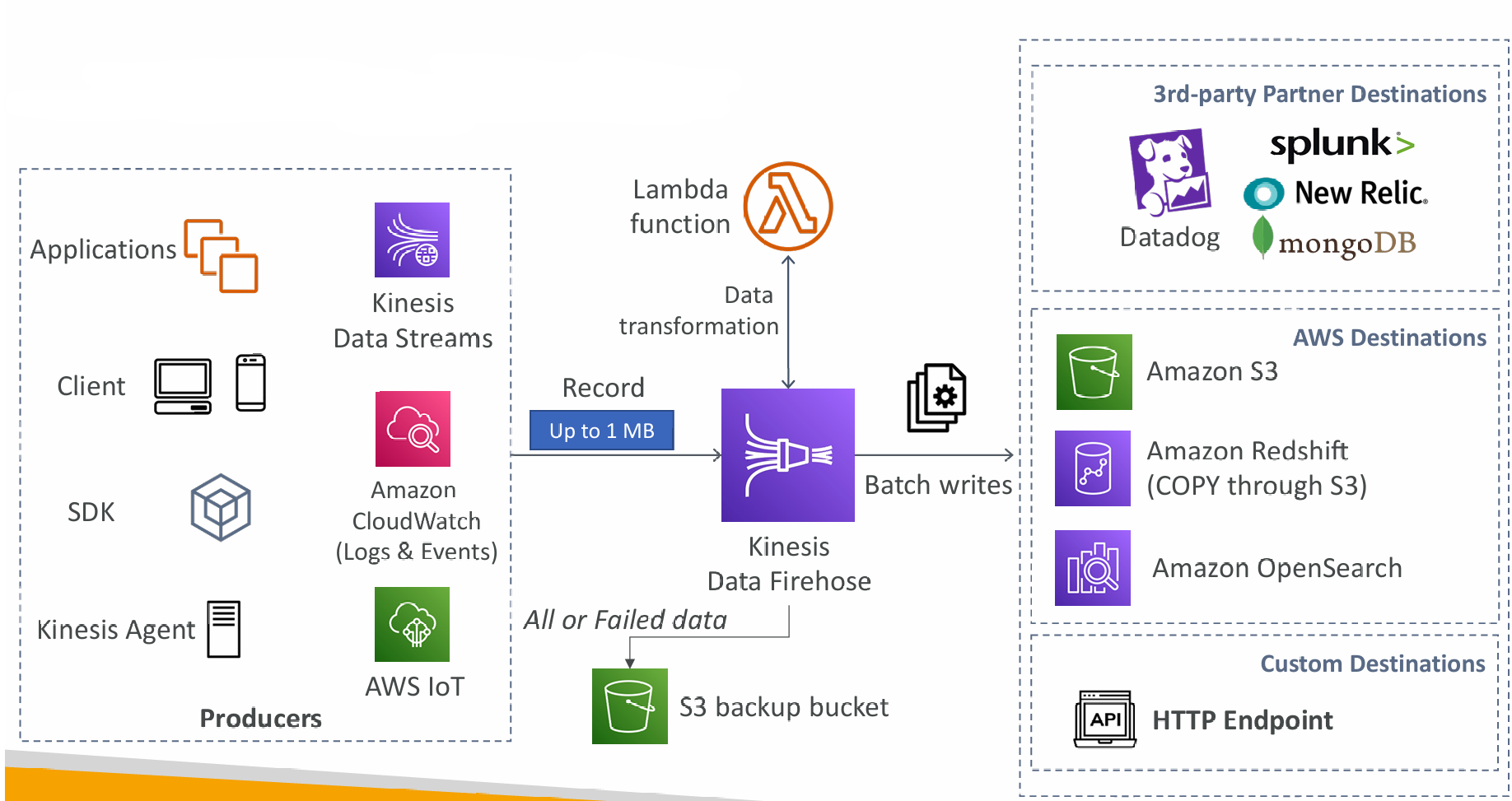
- Fully Managed Service, no administration, automatic scaling, serverless
- AWS: Redshift / Amazon S3 / OpenSearch
- 3rd party partner: Splunk / MongoDB / DataDog / NewRelic / …
- Custom: send to any HTTP endpoint
- Pay for data going through Firehose
- Near Real Time
- Buffer interval: 0 seconds (no buffering) to 900 seconds
- Buffer size: minimum 1MB
- Supports many data formats, conversions, transformations, compression
- Supports custom data transformations using AWS Lambda
- Can send failed or all data to a backup S3 bucket
Kinesis Data Streams vs Firehose
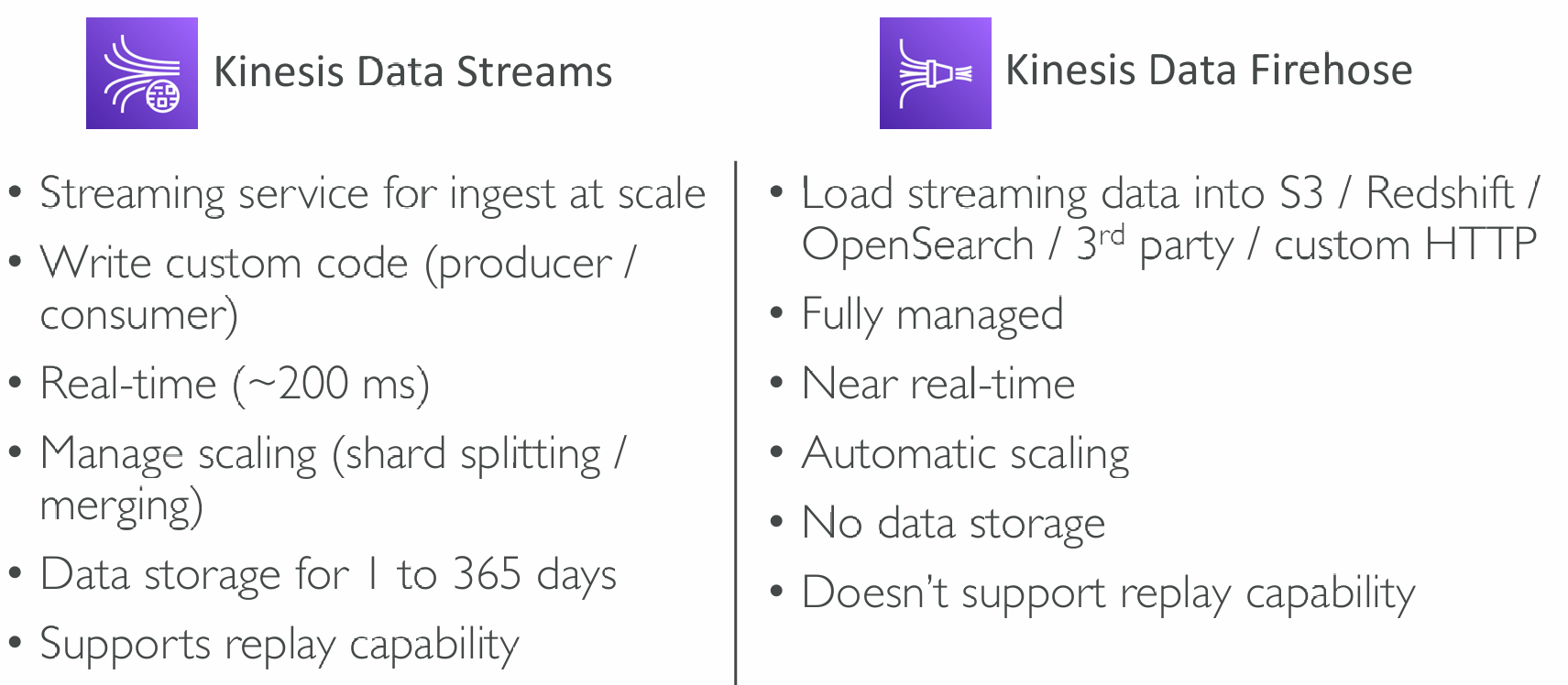
Data Analytics for SQL applications
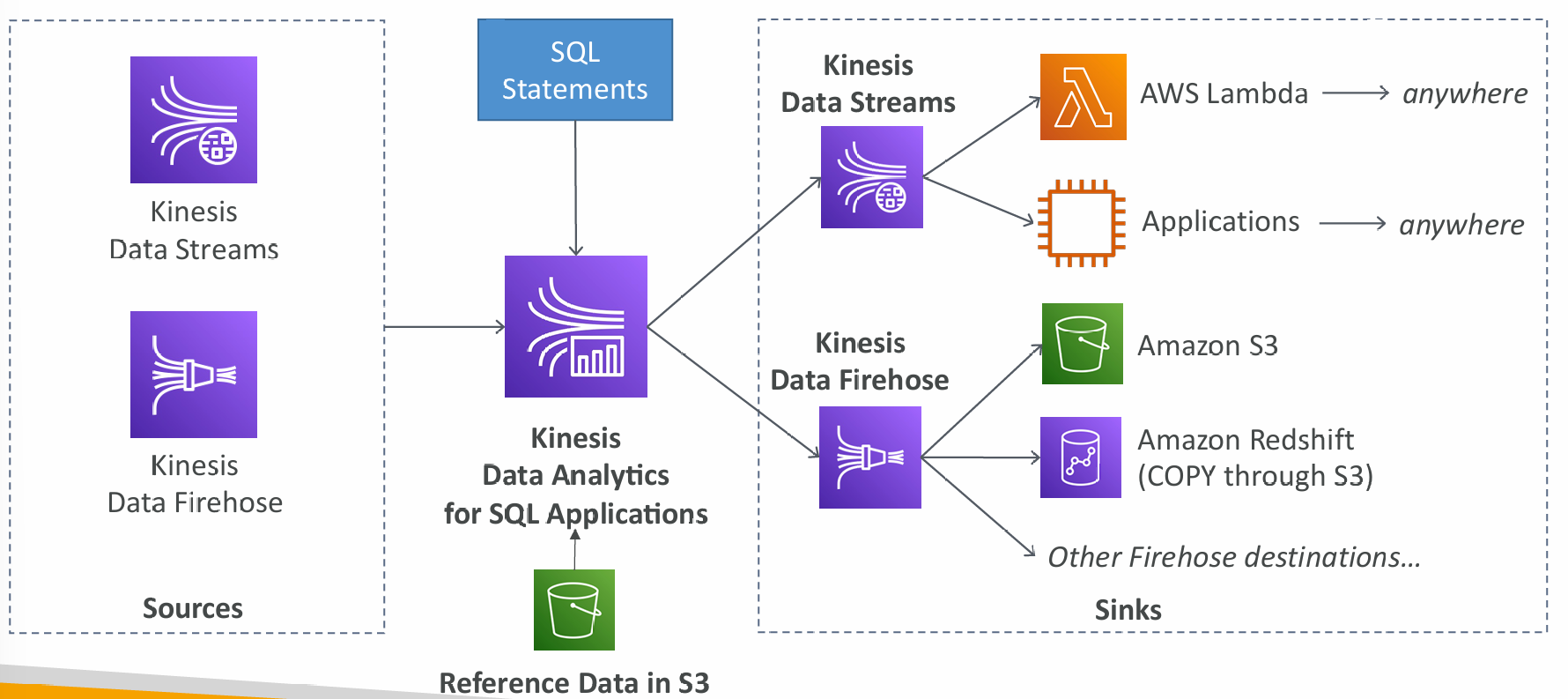
- Real-time analytics on Kinesis Data Streams & Firehose using SQL
- Add reference data from Amazon S3 to enrich streaming data
- Fully managed, no servers to provision
- Automatic scaling
- Pay for actual consumption rate
- Output:
- Kinesis Data Streams: create streams out of the real-time analytics queries
- Kinesis Data Firehose: send analytics query results to destinations
- Use cases:
- Time-series analytics
- Real-time dashboards
- Real-time metrics
Data Analytics for Apache Flink
Use Flink (Java, Scala or SQL) to process and analyze streaming data:

- Run any Apache Flink application on a managed cluster on AWS
- provisioning compute resources, parallel computation, automatic scaling
- application backups (implemented as checkpoints and snapshots)
- Use any Apache Flink programming features
- Flink does not read from Firehose (use Kinesis Analytics for SQL instead)
Kinesis vs SQS ordering
- Let’s assume 100 trucks, 5 kinesis shards, 1 SQS FIFO
- Kinesis Data Streams:
- On average you’ll have 20 trucks per shard
- Trucks will have their data ordered within each shard
- The maximum amount of consumers in parallel we can have is 5
- Can receive up to 5 MB/s of data
- SQS FIFO
- You only have one SQS FIFO queue
- You will have 100 Group ID
- You can have up to 100 Consumers (due to the 100 Group ID)
- You have up to 300 messages per second (or 3000 if using batching)
Ordering data into Kinesis
- Imagine you have 100 trucks (truck_1, truck_2, … truck_100) on the road sending their GPS positions regularly into AWS.
- You want to consume the data in order for each truck, so that you can track their movement accurately.
- How should you send that data into Kinesis?
- Answer: send using a “Partition Key” value of the “truck_id”
- The same key will always go to the same shard
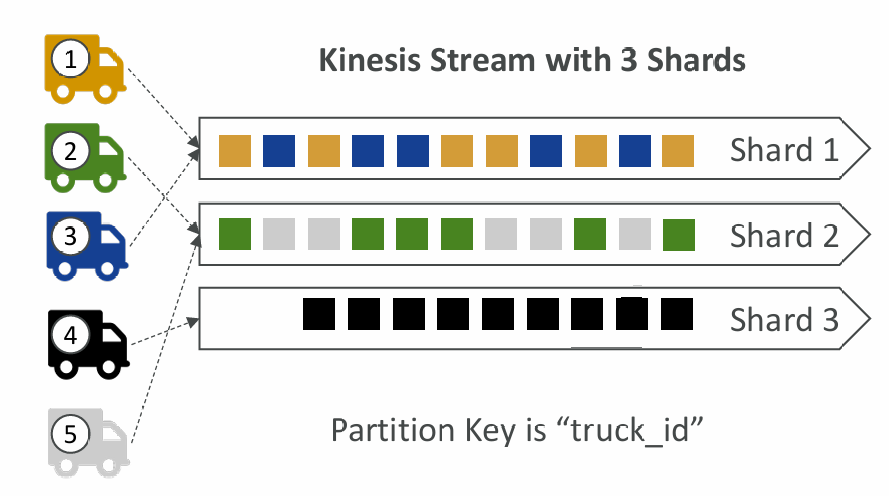
Ordering data into SQS
- For SQS standard, there is no ordering.
- For SQS FIFO, if you don’t use a Group ID, messages are consumed in the order they are sent, with only one consumer
- You want to scale the number of consumers, but you want messages to be “grouped” when they are related to each other
- Then you use a Group ID (similar to Partition Key in Kinesis)
SQS vs SNS vs Kinesis
